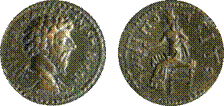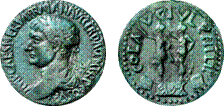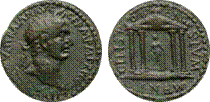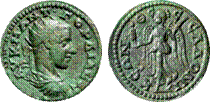AMPHIPOLIS
 An Athenian colony of strategic importance, near the fruitful Strymon vale and the Pangaion gold mines, Amphipolis was founded in 438/ 437 B.C., though the region had been inhabited in the prehistoric period.
An Athenian colony of strategic importance, near the fruitful Strymon vale and the Pangaion gold mines, Amphipolis was founded in 438/ 437 B.C., though the region had been inhabited in the prehistoric period.
After the Roman conquest of Macedonia (168 B.C.) Amphipolis was made the capital of Macedonia Prima, one of the four divisions into which Macedonia was divided. The Roman period was a time of prosperity within the bounds of Roman world dominion. As a station on the Via Egnatia and the capital of a rich hinterland, the city grew economically and culturally. It did indeed experience devastations and sackings, but with the support of the Roman emperors, particularly Augustus and Hadrian, it remained one of the most important urban centres in Macedonia until late antiquity.
APOLLONIA
 An ancient town in Macedonia, on the territory of present-day Albania, situated on the Adriatic coast by the mouth of the river Vyosa. It was founded in 588 B.C. by greek colonists. In 229 B.C. it came under the control of the Roman Republic. In 148 B.C. Apollonia become part of the Roman Province of Macedonia. The city flourished under Roman as a great and important center. Its decline began in the 3rd century A.D., when an earthquake changed the part of the Vjosa river.
An ancient town in Macedonia, on the territory of present-day Albania, situated on the Adriatic coast by the mouth of the river Vyosa. It was founded in 588 B.C. by greek colonists. In 229 B.C. it came under the control of the Roman Republic. In 148 B.C. Apollonia become part of the Roman Province of Macedonia. The city flourished under Roman as a great and important center. Its decline began in the 3rd century A.D., when an earthquake changed the part of the Vjosa river.
They minted silver drachmas from the 3rd until the 1st century BC. The city minted small series of greek imperial coins.
CASSANDREIA
 Cassandreia is an ancient town on the territory of today's Greece, situated on the Chalkidiki peninsula, between the Thermaikos and Cassandra gulfs in the Aegean sea.
Cassandreia is an ancient town on the territory of today's Greece, situated on the Chalkidiki peninsula, between the Thermaikos and Cassandra gulfs in the Aegean sea.
Until the Greek Imperial period the town issued limited quantities of pseudo-autonomous coins. The first emperor who struck Greek Imperial coins there was Claudius, and the last one – Phillipus I.
DIUM
 Dium, the Macedonian religious centre, was situated on the rich Pierian plain between the northern foothills of Mount Olympus and Thermaic gulf. Immediately after 31 B.C., by order of Augustus, a Roman colony was founded at Dium. Despite the settlement of Roman colonists there, the city preserved its Greek character, as manifested by the numerous Greek inscriptions that have been found. Dium never strusk a coinage of its own. Only when a Roman colony was founded in the time of Augustus, around 30 B.C., did the city start to produce a local bronze coinage which lasted until the reign of Gallienus in the middle of 3rd century.
Dium, the Macedonian religious centre, was situated on the rich Pierian plain between the northern foothills of Mount Olympus and Thermaic gulf. Immediately after 31 B.C., by order of Augustus, a Roman colony was founded at Dium. Despite the settlement of Roman colonists there, the city preserved its Greek character, as manifested by the numerous Greek inscriptions that have been found. Dium never strusk a coinage of its own. Only when a Roman colony was founded in the time of Augustus, around 30 B.C., did the city start to produce a local bronze coinage which lasted until the reign of Gallienus in the middle of 3rd century.
EDESSA
 The name under which Edessa figures in cuneiform inscriptions is unknown; the native name was Osroe, after some local satrap, this being the Armenian form for Chosroes; it became Ourhoï in Syriac, Ourhaï in Armenian, Er Roha in Arabic, commonly Orfa or Urfa, its present name. Seleucus Nicator, when he rebuilt the town in 303 B. C., called it Edessa, in memory of the ancient capital of Macedonia, which had a similar name (now Vodena). Under Antiochus IV (175-164 B.C.) the town was called Antiochia by colonists from Antioch who had settled there.
The name under which Edessa figures in cuneiform inscriptions is unknown; the native name was Osroe, after some local satrap, this being the Armenian form for Chosroes; it became Ourhoï in Syriac, Ourhaï in Armenian, Er Roha in Arabic, commonly Orfa or Urfa, its present name. Seleucus Nicator, when he rebuilt the town in 303 B. C., called it Edessa, in memory of the ancient capital of Macedonia, which had a similar name (now Vodena). Under Antiochus IV (175-164 B.C.) the town was called Antiochia by colonists from Antioch who had settled there.
On the foundation of the Kingdom of Osrhoene, Edessa became the capital under the Abgar dynasty. This kingdom was established by Nabatæan or Arabic tribes form North Arabia, and lasted nearly four centuries (132 B.C. to A.D. 244), under thirty-four kings. It was at first more or less under the protectorate of the Parthians, then of the Romans; the latter even occupied Edessa from 115 to 118 under Trajan, and from 216 to 244, when the kingdom was definitely suppressed to form a Roman province. The literary language of the tribes which had founded this kingdom, was Aramaic, whence came the Syriac.
PELLA
 At the beginning of the 5th century B.C. the capital of the Macedonian kingdom was transferred to Pella, on the shores of Lake Loudias, which communicated with the Thermaic Gulf.
At the beginning of the 5th century B.C. the capital of the Macedonian kingdom was transferred to Pella, on the shores of Lake Loudias, which communicated with the Thermaic Gulf.
Under Philip II and Alexander III Pella became a metropolis with an impressive complex of palaces and luxurious private houses. The city was gradually cut off from the sea due to the silting of the rivers Axios, Haliakmon and Loudias, and was extended and reorganized by Cassander.
Although the city was pillaged by the Romans, it did not cease to exist until the 1st century B.C., when it was destroyed, probably by an earthquake. In 30 A.D. the Roman colony of Pella ('Colonia Pellensis') was founded west of the city, on the site of present-day Nea Pella.
PHILIPPI
 In 360 B.C. colonists from Thasos founded a city named Krenides on the site of latter-day Philippi. In 356 B.C. Philip II captured this vitally important site and renamed it Philippi. The city was then fortified and settled by Macedonian colonists. Philippi continued to prosper in the Hellenistic period, although few monuments of the time have survived, as its constant occupation to the end of the early Byzantine years covered older constructions. Towards the end of the Hellenistic period Philippi gradually declined, to enjoy, however, a resurgence in Roman times.
In 360 B.C. colonists from Thasos founded a city named Krenides on the site of latter-day Philippi. In 356 B.C. Philip II captured this vitally important site and renamed it Philippi. The city was then fortified and settled by Macedonian colonists. Philippi continued to prosper in the Hellenistic period, although few monuments of the time have survived, as its constant occupation to the end of the early Byzantine years covered older constructions. Towards the end of the Hellenistic period Philippi gradually declined, to enjoy, however, a resurgence in Roman times.
STOBI
 Stobi was situated in the vicinity of Veles. It was first mentioned in the year 197 B.C. by Livius. In the period of Augustus (31 B.C. – 14 A.D.) the town became larger in size and much more populated. It got even larger when it was given a municipium status in the year 69 A.D. It was then when they started minting coins with the inscription "Municipium Stobensium". The citizens of Stobi enjoyed Ius Italicum and were citizens of Rome, and belonged to the Aemila and Tromentina tribes. The early and the late Roman period were the best periods in the history of Stobi.
Stobi was situated in the vicinity of Veles. It was first mentioned in the year 197 B.C. by Livius. In the period of Augustus (31 B.C. – 14 A.D.) the town became larger in size and much more populated. It got even larger when it was given a municipium status in the year 69 A.D. It was then when they started minting coins with the inscription "Municipium Stobensium". The citizens of Stobi enjoyed Ius Italicum and were citizens of Rome, and belonged to the Aemila and Tromentina tribes. The early and the late Roman period were the best periods in the history of Stobi.
THESSALONICA
 In 315 B.C. at the mouth of the Thermaic Gulf Cassander founded the city which was to become the third capital of the Macedonian kingdom, giving it the name of his wife Thessalonice, Alexander III's half-sister.
In 315 B.C. at the mouth of the Thermaic Gulf Cassander founded the city which was to become the third capital of the Macedonian kingdom, giving it the name of his wife Thessalonice, Alexander III's half-sister.
The Hellenistic city resulted from the forced resettlement of the inhabitants of 26 earlier settlements of the area. Following the defeat of Perseus at Pydna (168 B.C.), the city became the capital of the Second of the four 'merides' (portions) into which the Romans divided Macedonia.
Situated at a pivotal junction of the road network, the city became the most populous administrative and financial centre of the Province of Macedonia in the mid-2nd century A.D. The city flourished under Galerius, who made it his seat. Under Constantine the Great Thessalonice acquired also an artificial harbour.
In the year 168 B.C., when the Romans defeated Perseius, Macedonia was divided into 4 divisions (imerides) which had their temporary independence. In 148 B.C. Macedonia lost its independence and became a Roman province.
An Athenian colony of strategic importance, near the fruitful Strymon vale and the Pangaion gold mines, Amphipolis was founded in 438/ 437 B.C., though the region had been inhabited in the prehistoric period.
An ancient town in Macedonia, on the territory of present-day Albania, situated on the Adriatic coast by the mouth of the river Vyosa. It was founded in 588 B.C. by greek colonists. In 229 B.C. it came under the control of the Roman Republic. In 148 B.C. Apollonia become part of the Roman Province of Macedonia. The city flourished under Roman as a great and important center. Its decline began in the 3rd century A.D., when an earthquake changed the part of the Vjosa river.
Cassandreia is an ancient town on the territory of today's Greece, situated on the Chalkidiki peninsula, between the Thermaikos and Cassandra gulfs in the Aegean sea.
Dium, the Macedonian religious centre, was situated on the rich Pierian plain between the northern foothills of Mount Olympus and Thermaic gulf. Immediately after 31 B.C., by order of Augustus, a Roman colony was founded at Dium. Despite the settlement of Roman colonists there, the city preserved its Greek character, as manifested by the numerous Greek inscriptions that have been found. Dium never strusk a coinage of its own. Only when a Roman colony was founded in the time of Augustus, around 30 B.C., did the city start to produce a local bronze coinage which lasted until the reign of Gallienus in the middle of 3rd century.
The name under which Edessa figures in cuneiform inscriptions is unknown; the native name was Osroe, after some local satrap, this being the Armenian form for Chosroes; it became Ourhoï in Syriac, Ourhaï in Armenian, Er Roha in Arabic, commonly Orfa or Urfa, its present name. Seleucus Nicator, when he rebuilt the town in 303 B. C., called it Edessa, in memory of the ancient capital of Macedonia, which had a similar name (now Vodena). Under Antiochus IV (175-164 B.C.) the town was called Antiochia by colonists from Antioch who had settled there.
At the beginning of the 5th century B.C. the capital of the Macedonian kingdom was transferred to Pella, on the shores of Lake Loudias, which communicated with the Thermaic Gulf.
In 360 B.C. colonists from Thasos founded a city named Krenides on the site of latter-day Philippi. In 356 B.C. Philip II captured this vitally important site and renamed it Philippi. The city was then fortified and settled by Macedonian colonists. Philippi continued to prosper in the Hellenistic period, although few monuments of the time have survived, as its constant occupation to the end of the early Byzantine years covered older constructions. Towards the end of the Hellenistic period Philippi gradually declined, to enjoy, however, a resurgence in Roman times.
Stobi was situated in the vicinity of Veles. It was first mentioned in the year 197 B.C. by Livius. In the period of Augustus (31 B.C. – 14 A.D.) the town became larger in size and much more populated. It got even larger when it was given a municipium status in the year 69 A.D. It was then when they started minting coins with the inscription "Municipium Stobensium". The citizens of Stobi enjoyed Ius Italicum and were citizens of Rome, and belonged to the Aemila and Tromentina tribes. The early and the late Roman period were the best periods in the history of Stobi.
In 315 B.C. at the mouth of the Thermaic Gulf Cassander founded the city which was to become the third capital of the Macedonian kingdom, giving it the name of his wife Thessalonice, Alexander III's half-sister.